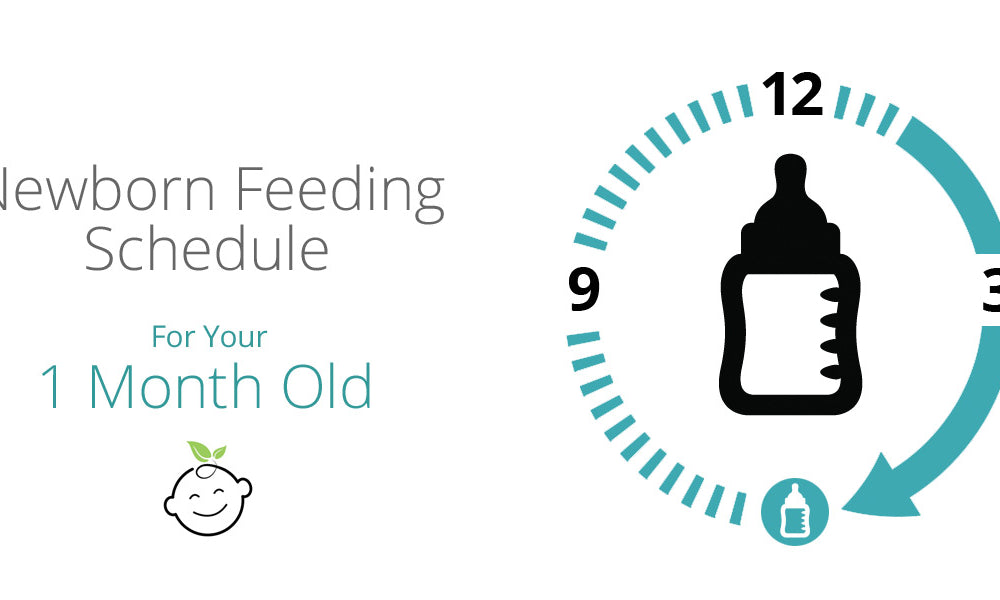Feeding Schedule for Your 1-Month-Old

by Baby Earth
Oct 24, 2018
Deciding on a feeding schedule for your 1-month-old isn't a journey with just one road. We're here to help you navigate the path and make the best decision on how to schedule feedings for your new baby.
Feeding Schedule for your 1-Month-Old
There are several options to choose from when deciding how to feed your baby. Some parents choose to feed on demand, which means that whenever their baby shows any signs of hunger, the parents feed their baby. Some parents adhere to a strict schedule and refuse to waver from it. And, some parents do a mix of both on-demand and scheduled feedings, which means that the parents usually feed on a schedule, but if their baby seems especially hungry, they will adjust the schedule as needed.
If you've decided to do scheduled feedings or a mix of on-demand and scheduled feedings, I've created a sample schedule that will fit the average 1-month-old's feeding needs.
While this schedule is for parents who choose to do scheduled or mixed schedule feedings, I recommend against having such a rigid schedule that you miss your child's hunger cues. During growth spurts, your child will be hungry more often, so it's important not to ignore those hunger cues.
If your child does veer off his or her normal feeding schedule during growth spurts, don't worry! You will eventually get your baby back on his or her schedule, and all will be well with the world.
Feeding Cues
So, what are feeding cues? How can you tell if your baby is hungry or needs a diaper change?
While there isn't an exact science to knowing if your baby is hungry, needs a diaper change, or needs some other attention, there are a few things that are usually signs of hunger. Gerber has compiled a list of a baby's hunger cues:
- Sucking on hands or fingers or putting fist in mouth
- Opening mouth wide when something touches his or her chin or lips
- Cries or fusses
- Moves or licks and smacks lips
- Makes small noises
How Much Should My Baby Eat at Each Feeding?
At 1 month old, your formula-fed baby will be eating approximately four ounces of formula at each feeding; however, the amount of formula your baby needs can vary, depending on the child weight. On average, a baby should eat 2 1/2 ounces of formula per pound of weight every day until they are 6 months old.
While figuring out how much to feed a formula-fed baby is fairly straightforward, figuring out how much or how long to feed a breastfed baby isn't quite so easy. On average, though, in the early months before your child becomes an efficient feeder, you will feed your baby approximately 15-20 minutes from each breast or allow them to feed for 30 (or longer) minutes from one breast if you choose to only feed on one breast at each feeding.
Although these numbers are a guide, they are not an exact measurement, so if you are concerned that your baby isn't getting enough, here a few signs to look for to see if your baby is getting enough milk:
- Your breasts feel softer after the feeding.
- Your baby seems calm and satisfied.
- Your baby is wetting at least six diapers a day.
- Your baby is continuously gaining weight.
At 1-month-old, your breastfed baby will feed, on average, every two to three hours during the day (and that time may be able to be stretched out to every four (possible five) hours at night). A formula-fed baby, on the other hand, will feed every four hours during the day (and that can be stretched out to five hours - or more - at night).
Sample Breastfeeding Schedule for a 1-Month-Old
Feeding 1: 6:30 a.m.
Feeding 2: 9:00 a.m.
Feeding 3: 11:30 a.m.
Feeding 4: 2:00 p.m.
Feeding 5: 4:30 p.m.
Feeding 5: 7:00 p.m.
Feeding 6: 9:30 p.m.
Feeding 7: 12:00 a.m.
Feeding 8: 4 a.m.
Sample Formula Feeding Schedule for a 1-Month-Old
Feeding 1: 6:30 a.m.
Feeding 2: 9:30 a.m.
Feeding 3: 1:30 p.m.
Feeding 4: 4:30 p.m.
Feeding 5: 7:30 p.m.
Feeding 6: 10:30 p.m.
Feeding 7: 2:30 a.m.
The above schedules are just a sample of what your feeding schedule may look like. You may start your day earlier or later, you may feed your baby every two hours instead of 2 1/2 to three, your baby may sleep slightly longer at night -- all of that is OK! Choose the schedule that works best for you and your baby.
More Feeding Guide Articles




